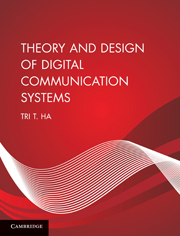Book contents
- Frontmatter
- Contents
- Preface
- Acknowledgements
- List of symbols
- List of abbreviations
- 1 Introduction
- 2 Deterministic signal analysis
- 3 Random signal analysis
- 4 Information theory and channel coding
- 5 Communication link analysis
- 6 Modulation
- 7 Demodulation
- 8 Spread spectrum
- 9 Intersymbol interference and equalization
- 10 Fading channels
- Index
- Frontmatter
- Contents
- Preface
- Acknowledgements
- List of symbols
- List of abbreviations
- 1 Introduction
- 2 Deterministic signal analysis
- 3 Random signal analysis
- 4 Information theory and channel coding
- 5 Communication link analysis
- 6 Modulation
- 7 Demodulation
- 8 Spread spectrum
- 9 Intersymbol interference and equalization
- 10 Fading channels
- Index
Summary
This book was written with two goals in mind: to provide the underlying principles of digital communication and to study design techniques integrated with real world systems. The ultimate aim of a communication system is to provide reliable transmission of information to the user(s). This fundamental foundation was established in 1948 by Claude Shannon, the founding father of information theory, and led eventually to the development of modern digital communication. Analog communication is near extinction or at the very gate of it. The full spectrum dominance of digital communication has arrived and new frontiers are being established every decade; from cellular systems to wireless LAN and MAN, the bit rates are being pushed ever higher for ubiquitous mobile applications.
Knowing the limit of digital transmission is vital to the design of future communication systems, particularly mobile wireless systems, where both spectrum and power are precious resources, and design techniques can be used to manipulate these two main resources to fit real world applications. No single technique can cover all the requirements of a modern communication system, which makes it necessary for students to understand the intricate web between subsystems, each designed to support others to achieve the common goal of reliable communication.
- Type
- Chapter
- Information
- Theory and Design of Digital Communication Systems , pp. xvii - xviiiPublisher: Cambridge University PressPrint publication year: 2010

